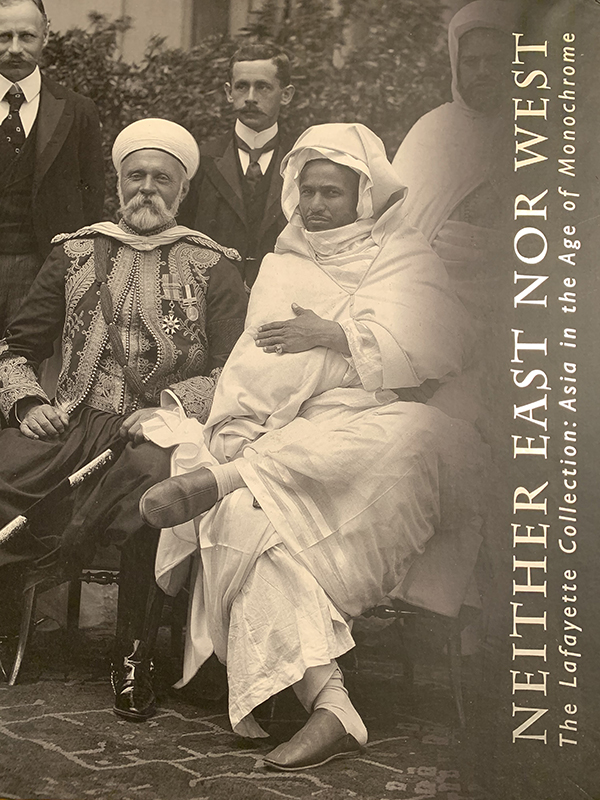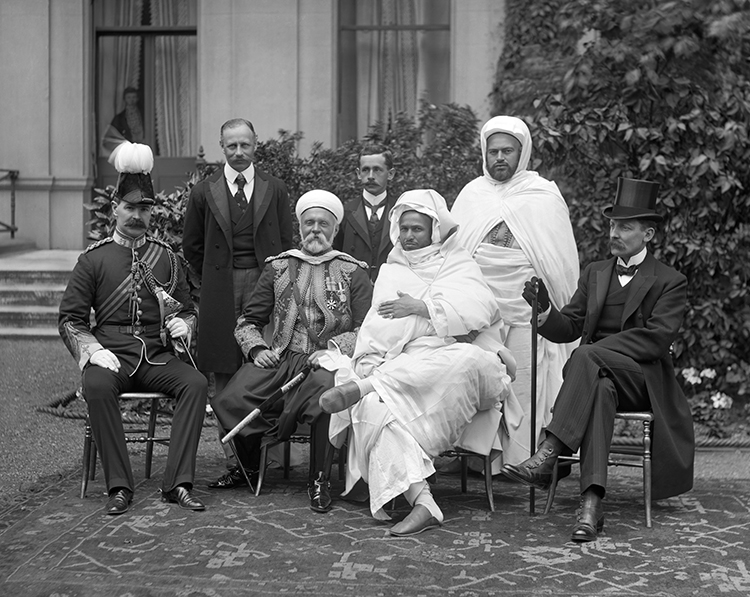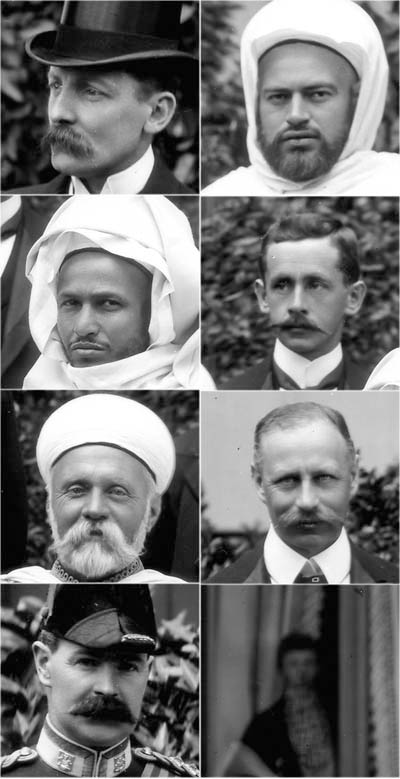-
Sitters:
(left to right)
- Colonel
Bernard Ramsden James (1864-1938) Intelligence Office and Soldier
- Allan Maclean
(1858-1918) Diplomat
- Kaïd, General
Sir Harry Aubrey de Maclean (1848-1920) Soldier and Instructor to the
Moroccan army
- Alfred Irwin
(1865-1921) Interpreter
- "
Diplomatic Service, Alfred Irwin to be Interpreter and Dragoman to Her Majesty's Legation, Tangier." (The London Gazette, 1 October 1895, p. 5410
- Hadj el'Arbi
bel-Mehdi el-Menebhi ( ) Moroccan Minister of War and Emissary of Sultan
Moulai Abdul Aziz
- Sid Abderrahman
Bargash ( ) Diplomat
- Sir Robert
Follett Synge (1853-1920) Marshal of Ceremonies
NB Figure peering through window
behind Colonel James
Date:
10 June 1901.
|
|
|
Another
image by Lafayette of Kaid MacLean,
published in The Illustrated London News, 13 July 1907
|
Occasion:
Mission from Sultan of Morocco to congratulate King Edward VII on his
accession. See also inset below.
Location:
St. James's Palace.
Descr:
FL seated.
Costume:
- (Colonel
James) Uniform of Captain in Royal Warwickshire Regiment;
- (Kaïd Maclean)
Zoave dress
Orders,
Decorations & Medals: (Kaïd Maclean) The
Most Distinguished Order of St. Michael and St. George (Companion, C.M.G.),
cr. 1898.
Image published in:

BACKGROUND
| Source:
The Illustrated London News, 15 June 1901, p 853 The Moorish
Embassy {1901} |
| For
the first time since the reign of Charles II., a Moorish Embassy
has waited upon the British Sovereign. The mission, which has been
sent by the Sultan of Morocco to congratulate King Edward on his
accession, arrived at Portsmouth on June 6. The chief members of
the mission, the Grand Vizier and Kaid Maclean, commander-in-chief,
with a retinue of twenty-seven persons, sailed on board the Diadem,
placed at their disposal by the British Government. In their splendid
robes and richly ornamented yataghans, the gentlemen of the party
lent unusual picturesqueness to the commonplace surroundings of
a railway platform. The ladies, too, were probably no whit behind
them in this particular, but owing to the rigour of Oriental etiquette,
no eye of man was permitted to gaze upon them. The platform had
to be cleared before they alighted from the train. It is known,
however, that they wore sweeping black-hooded robes, over which
fell the white yashmak. On June 10, the Embassy attended at St.
James's Palace, where the members were received by the King. Shortly
after twelve o'clock the Ambassador and his suite arrived, and were
received by the Hon. Sir W.J. Colville. In the Throne-Room the Ambassador,
(Cid-el-Mehedi el Menebhi, read the address of congratulations from
the Sultan of Morocco, Kaid Maclean acting as interpreter. King
Edward replied reciprocating the sentiments of personal friendship
which the Sultan of Morocco had expressed through his Ambassador,
and wishing that the relations between Great Britain and Morocco
should continue cordial and intimate. |
| |
| Source:
Vice-Admiral C.V. Usborne, The Conquest of Morocco, London,
1931 |
| Maclean's
mission to England [p 62 n] At the same time the Sultan sent Sidi
Menebbi el Meneddi [sic] on a mission to London. It only achieved
minor results, however, as Britain did not wish to become involved
in Morocco. Subsequently, when on the 6th August, 1902, M. Cambon,
{French} ambassador in London, suggested to Lord Lansdowne that
the time had come to discuss Morocco's future, the Sultan, alarmed
at the rumours which reached him, sent Caïd Maclean, an Englishman
in his service, post-haste to London to implore British help in
maintaining Morocco's integrity. But he met with the coldest reception.
Sir Thomas Saunderson wrote to Sir Arthur Nicolson, "Caïd Maclean
is rapidly developing into a perfectly phenomenal bore." |
| |
| Source:
Charles-André Julien, le maroc face aux impérialismes 1415-1956,
Paris, {year ?} |
| The
French version of Maclean's background [p 40 n] {trans} ... Harry
Aubrey de Vere Mac Lean [sic], born in 1848, who had to leave the
British army, either for having had a liaison with a Spanish woman
or for having contracted debts in Gibralter, and towards 1875 entered
into the service of Mulay Hassan... As a "Qaïd" he lived
à la marocaine. He exercised a strong influence on Abdul Aziz from
1900 to 1906. In 1901 he was knighted by the British crown. Making
up the British group were also the correspondent of The Times, Walter
B. Harris and the doctor Egbert Verdon. |
| |
| Source:
A.G.P. Martin, Quatre siècles d'histoire marocaine, Paris,
1923 |
| Harry
Maclean revealed as secret agent of British [pp 3901-1] {trans}
This makhzen comprised of the allaf El-Menebhi, the grand vizir
Sid Feddoul Gharnit, the {minister of foreign affairs} Sid Abdelkrim
ben Slimane, the {minister of finance}, and Ben Yaich... All of
these people could be manipulated freely by Harris {see above page
9) when El-Menebhi went, with his damned soul Mac Lean {sic}, to
represent the Sultan at the festivities for the coronation of the
king of England who revealed the English designs when he elevated
the former deserter, now his long-time salaried secret agent, to
Sir Harry Mac Lean, baronet. |
| |
| Source:
G.H. Selous, Appointment to Fez, London, 1956 {SOAS 964.04}
Biography of Menebhi [pp 271-2] |
| As
a youth Menébhi had joined the Shereefian Court at Marráksh and
there served under B Ahmed, the famous Grand Vizier and Regent for
Sultan Moolay 'Abdul-Azeez... during the latter's minority after
the death of his remarkable, warrior father, Sultan Moolay El-Hassan,
in 1894. In time and while still a young man Menébhi became 'Allaf
or Minister of War to the young Sultan, and as a a commander in
the field had performed prodigies of valour against rebellious tribes.
Following the defeat, however, of Moolay 'Abdul-'Azeez by his brother,
Molay 'Abdul-Hafeed, who thereupon became the reigning Sultan, the
former and Menébhi retired to Tangier.... Simultaneously, the British
Government extended its protection to Menébhi, making him one of
the very few British political protégés under Article XVI of the
Madrid Convention of 1880. At the time of his death early in 1941
he had enjoyed full British status for over thirty years. Menebhi
invested with GCMG [p 272] Menébhi attended the coronations of King
Edward VII, King George VI, and King George VI as Special Envoy
from the Sultan of Morocco, and it was while staying at Windsor
as a guest of King Edward VII that he was invested with the insignia
of a G.C.M.G. |
| |
| Source:
Sir Sidney Lee, King Edward VII: A Biography, London, 1927
{JM} [Vol II, pp 219-221] |
|
The
British version of events in Morocco The prudence of maintaining
friendly relations with the Sultan of Morocco had long been recognised
by the King and Lord Lansdowne, yet Morocco's position in regard
to theinternational rivalries of Euorpe abounded in irony. The
government of that country had long been distracted by civil war.
The natives of the interior were in chronic rebellion against
the rule of the Sultan at Fez, while the French, as the rulers
of the neighbouring province of Algiers, were in frequent conflict
with the Moorish settlements near their frontier, and claimed
a predominant interest in the pacification and good government
of Morocco. France was clearly pursuing a policy of encroachment
on Moroccan indpendence, which did not meet with Euorpean approval.
British commercial interests in Morocco were substantial, and
the French policy of expansion there was at first viewed with
suspciion. Germany's interest in the country was admittedly insignificant,
but Great Britain's anxiety to check the French advance suggested
both to British and German statesman a combination which should
thwart effectively French Moroccan ambitions, but, as we have
seen that intention was frustrated by Germany's "policy of
reserve."
Meanwhile,
in June 1901 the Moroccan government sent missions to the Powers
mainly to seek relief from the French encroachments. The mission
to England, which consisted of Kaid el Mehedi el Menebie, the
War Minister, and Kaid Maclean, the Scottish Commander-in-Chief
in the Moroccan service, visited King Edward on 10th June, and
congratulated him on his accession. After a tour in the provinces
the mission was again received in audience by the King, who gave
a G.C.B. for conveyance to the Sultan, and conferred the G.C.M.G.
on el Mehedi and a K.C.M.G. on Kaid Maclean.
The
mission was frankly an assertion of Moroccan independence. Sir
Arthur Nicolson, British minister at Tangier, who accompanied
it, was active against France, and suggested to Baron von Eckardstein,
on Lord Landsdowne's behalf, an Anglo-German agreement for the
peaceful penetration of Morocco while maintaining its independence.
The same Mission visited Berlin in July, where it was received
by the Kaiser, whist another Mission under Sidi Abd-ul-Krim ben
Sliman went to Paris and St. Petersburg to protest against the
French raids from Algiers.
Soon
after this the English attitude to Morocco completely changed,
and England discovered that on a recognition of French claims
and general entente could be based. A year later, in September
1902, Kaid Sir Harry Maclean, who was completely in the Sultan's
confidence, arrived in England with a letter from the Sultan to
King Edward. The Kaid hoped to raise a loan in England with a
view to developing Morocco's mineral resources. He carried with
him a second autograph letter from the Stulan to the Kaiser, also
soliciting favours for his country. The Sultan was anxious that
England should join Germany in guaranteeing the integrity of Morocco
for a term of seven years, and Maclean, who regarded German trade
as the dominant factor in the affairs of Morocco, told the King's
secretary that only if the King were unable to help and protect
the Sultan would he deliver theletter from his master to the Kaiser
in Berlin. Lord Lansdowne warned the King to treat Maclean with
reserve. "The Moors are springing mines upon us," he
wrote (September 27, 1902), and urged him to give Maclean no advice
as to whether he should proceed to Berlin to consult the Kaiser.
The King consented to receive the Kaid at Balmoral only on condition
that he should not raise the issue of an approach to the Kaiser,
and the interview thus became one of personal courtesies only.
Early in 1902 M. Cambon discussed with Lord Lansdowne the future
of Morocco, and the rumour ran in Paris that the British Foreign
Minister had admitted the paramount interest of France in that
country. On 25th February 1903, the King wrote to inquire into
the truth of this rumour and whether the question of partitioning
Morocco between France and Spain had been discussed. Lord Lansdowne
replied on 7th March, referring at length to his conversations
with M. Cambon, and indicated M. Cambon's wish that England should
arrange a partition of Morocco between France and Spain.
|
| |
| Source:
Sir Lionel Cust, King Edward VII and His Court, London 1930
{JM} Deputation from Morocco and painting [pp 100-101] |
| The
earliest deputation to arrive was one from the Sultan of Morocco,
which arrived in June 1901, headed by the War Minister in Morocco,
and Kaid Maclean, a Scotsman and Commander-in-Chief in the Moroccan
service. Although the Court was in deep mourning, the King decided
to receive this deputation on the throne, and the reception was
duly arranged to take place at St. James's Palace on June 10. As
this was the first function of the sort which King Edward was to
hold, the King wished to have a painting made to commemorate the
event. Mr. J. Seymour Lucas, R.A., was selected for this purpose,
and I had the duty of arranging for the painter to get a suitable
view of the ceremony without intruding upon the proceedings. The
scene was unusually picturesque, because the white robes of the
Moroccan envoys were set off by the deep black of Queen Alexandra's
dress, set as they were in general surroundings of red and gold
in the Throne Room at St. James's Palace. The result was a very
charming painting on a small scale, which is now at Buckingham Palace.
|
| |
| Source:
The Times, 11 June 1901, p 5e. {Court Circular} |
|
His
Majesty received a Special Mission from His Imperial Majesty the
Sultan of Morocco at St. James's Palace this afternoon...
The
Special Mission consistedof the following:- Ci al Mehedy ben l'Arbi
el Menebhi (Ambassador), Kaid Maclean, Ci el Hadj Omar Tazzi (1st
Secretary) Ci Abderrahman Bargash (2nd Secretary) Ci Zobeir Skeerj
(interpreter) Ci Hamo (3rd Secretary) Kaid el Arby (Head of Sultan's
Camp), and Ci Bushta (Chamberlain to the Ambassador). Mr. R.F.
Synge (of the Foreign Office), Captain B.R. James (East Surrey
Regiment), Mr Allen Maclean (Consul at Casablanca), and Mr Alfred
Irwin (Interpreter to the British Legation at Tangier) were specially
attached to the Mission. The Special Mission was received by Colonel
the Hon. Sir William Colville, and was introduced into the presence
Their Majesties by the Marquis of Lansdowne.
|
| |
| Source:
Major-General Lord Edward Gleichen, A Guardsman's Memories, London,
1932 {BL 010815.i.30} [pp242-2] |
|
This
latter {period of leave} -- after a short visit on duty to Khartoum
-- I got between June and September, and spent partly in looking
after the representative of the Sultan of Morocco for King Edward's
Coronation, one Sidi Abdurrahman ben Abd es Sadek, an old acquaintance
as it turned out, for he was Governor of Larache when I passed
through there in 1893. It was Irwin, the Legation interpreter
attached to the Mission, who really did all the hard work; and
he told me that when, on the first night of their arrival in London,
he had distributed them totheir respective bedrooms, he went round
them afterwards to see whether they were all right. One and all
of them complained of cold; and no wonder, for they were all lying
on top of their beds. The poor people had never seen a European
bed before, and did not know they couldget inside. And they were
most grateful on being shown how. My chief difficulty, on the
other hand, was to avoid being suffocated whenever I took the
Moorish potentate out for a drive; for he was a vast man and,
as usual, wore the equivalent of four or five suits of clothes
ion the shape of haiks, jelabs, burnuses and shirts and drawers
of all kinds. But the result was most impressive -- in more senses
than one. In the event, of course, the King's Coronation in June
had to be put off at the last minute, and my Moorish friend was
consequently unable to stay for the real one in August. But he
had one pleasant evening at the opera with Miss Gertrude Bell;
for that marvellous lady, although she had never been in Morocco
and knew no Moghrebbin dialect, conversed with him fluently in
Quranic Arabic, and he, being of course a man of education, responded
with ease.
|
| |

Photographer:
Lafayette Ltd., 179 New Bond Street, London.
- Evidence
of photographer at work: -
No of poses:
1.
Copyright:
V&A Provenance: Pinewood Studios; acquired 1989.

References:
- Biog:
(Colonel James) Who's Who;
- (Allan Maclean)
Who's Who;
- (Kaïd Maclean)
Dictionary of National Biography; Who's Who; The
Times, 6 February 1920, p 11d; Charles-André Julien, Le
Maroc face aux impérialismes 1415-1956, Paris (ND), p 40n;
- (Alfred
Irwin) Who's Who;
- (Hadj el'Arbi
bel-Mehdi el-Menebhi) G.H. Selous, Appointment to Fez,
London, 1956, pp 271-2; Edmunde Burke III, Prelude to Protectorate
in Morocco: Precolonial Protest and Resistance, 1860-1912,
Chicago, (year ?), pp 48-50;
- (Sid Abderrahman
Bargash) The Times, 11 June 1901, p 5c;
- (Sir R.F.
Synge) Who's Who.
Date:
The Times, 11 June 1901, p 5e.
Occasion:
The Times, 11 June 1901, p 5e; The Ilustrated London
News, 15 June 1901, p 853; Sir Sidney Lee, King Edward
VII: A Biography, London, 1927, Vol II, pp 219-221; Sir Lionel
Cust, King Edward VII and His Court, London, 1930, pp 100-101;
Vice-Admiral C.V. Usburne, The Conquest of Morocco, London,
1931, p 62n; G.H. Selous, Appointment to Fez, London, 1956,
p 272.
Costume:
(Qaïd Maclean) Mrs. S.K. Hopkins, Head of Uniforms,
Badges & Medals, The National Army Museum.
Orders,
Decorations & Medals: A.R. Litherland & E.T. Simpkin,
Spink's Standard Catalogue of British Orders, Decorations and Medals,
London, 1990, pp 35-36.
Reproduced:
The Queen, 22 June 1901, p 1029; (version) The Sketch,
19 June 1901, p 329; The Graphic, 22 June 1901, p 847.

Additional
Information: -

Acknowledgements:
-

|


